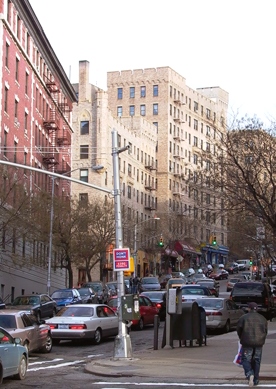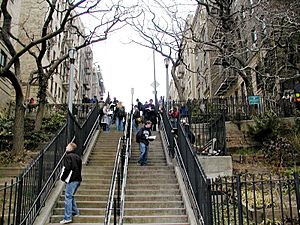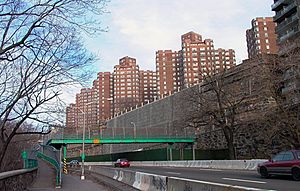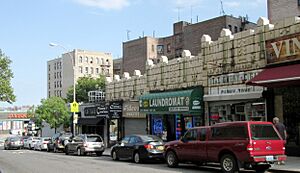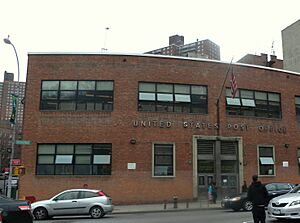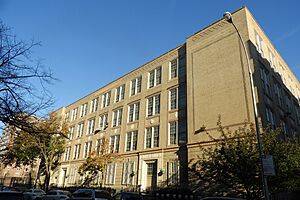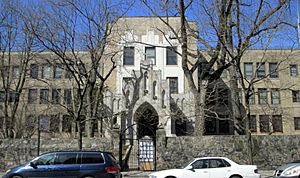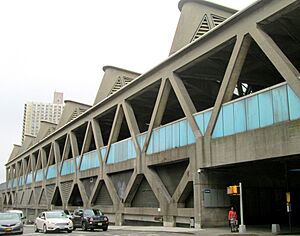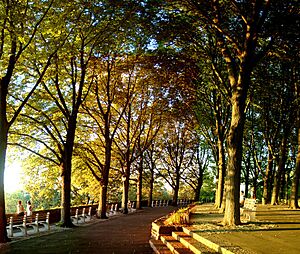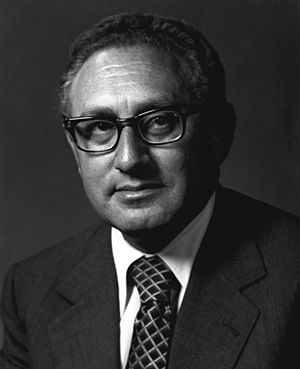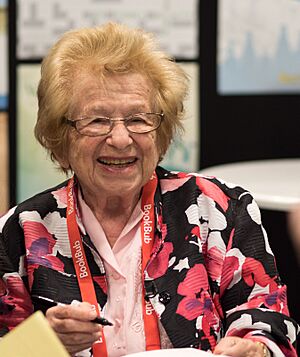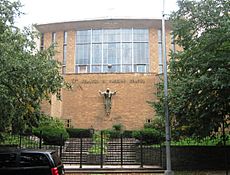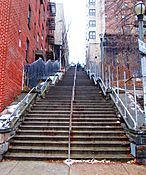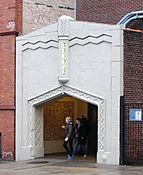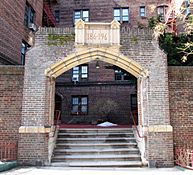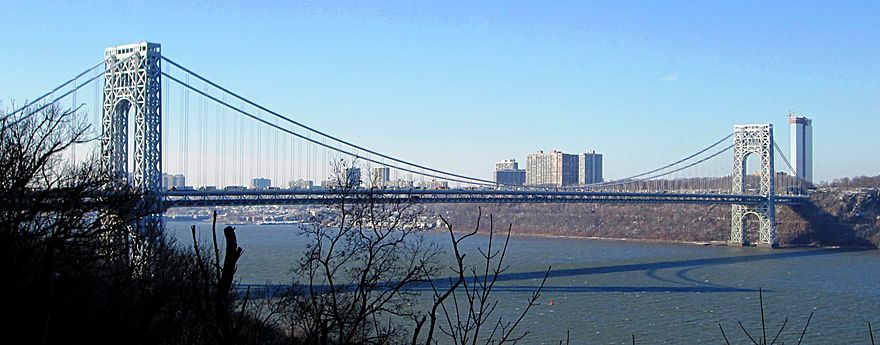Hudson Heights, Manhattan facts for kids
Quick facts for kids
Hudson Heights
|
|
|---|---|
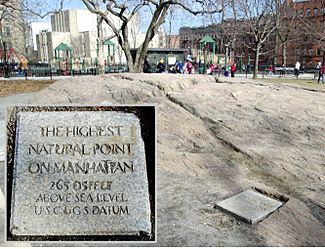
The highest point on Manhattan is in Bennett Park; the inset shows the marker seen on the lower right of the larger image
|
|
| Country | |
| State | |
| City | New York City |
| Borough | Manhattan |
| Population | |
| • Total | 20,000 (2010) |
| Time zone | UTC– 05:00 (Eastern) |
| • Summer (DST) | UTC– 04:00 (EDT) |
| ZIP Codes |
10033 and 10040
|
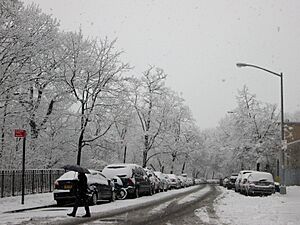
Hudson Heights is a neighborhood in Washington Heights, located in Upper Manhattan, New York City. Most homes here are apartment buildings, many of which are co-ops. They were mostly built between the 1920s and 1940s. You'll often see cool styles like Art Deco and Tudor Revival in the buildings. Two famous apartment complexes are Hudson View Gardens and Castle Village. Both were developed by Dr. Charles V. Paterno.
This neighborhood sits on a high area, like a plateau, overlooking the Hudson River to the west. It also looks over the Broadway valley of Washington Heights to the east. Hudson Heights is home to the highest natural point in Manhattan, which is found in Bennett Park. This spot is about 265 feet (81 meters) above sea level.
At the northern end of the neighborhood, you'll find Fort Tryon Park. This park was created by John D. Rockefeller Jr. and given to the city in 1931. Inside the park is The Cloisters, which is part of the Metropolitan Museum of Art. It holds an amazing collection of Medieval art.
Contents
Where is Hudson Heights?
In the 1990s, real estate agents started using the name "Hudson Heights." This was part of a trend to make areas sound more appealing to new residents.
Like many New York City neighborhoods, the exact borders of Hudson Heights can be a bit unclear. One way to describe it is that it's bordered by the Hudson River to the west, Broadway to the east, 173rd Street to the south, and Fort Tryon Park to the north. Another way to define it is that it's only the area on top of the high ridge. This ridge physically separates it from the rest of Washington Heights.
By this second definition, Hudson Heights is bordered by the Henry Hudson Parkway to the west. To the east, it's bordered by Fort Washington Avenue. To the south, it's West 181st Street, and to the north, it's Fort Tryon Park. The neighborhood sits on a ridge that offers views of the river to the west and the Broadway valley to the east.
The main streets running north and south are Fort Washington Avenue, Pinehurst Avenue, and Cabrini Boulevard. Riverside Drive runs along the bottom of the ridge to the west. Bennett Avenue and Overlook Terrace do the same on the east. The streets running east and west are numbered from West 181st Street to West 190th Street.
History of Hudson Heights
Early Days (17th and 18th Centuries)
Before Europeans arrived, the Lenape Native Americans lived on the island they called Mannahatta. In 1626, the Lenape traded the island to Peter Minuit for goods. He named the island New Amsterdam. The area north of central Manhattan was called Niew Haarlem.
During the American Revolutionary War, the British took control. General George Washington and his Continental Army camped on the high ground here. They called it Fort Washington to watch the British soldiers. After a defeat on November 16, 1776, in the Battle of Fort Washington, the Continental Army left. The British took over and renamed it Fort Knyphausen. This spot is now Bennett Park.
Near the fort was the Blue Bell Tavern, located where Broadway and West 181st Street are today. In 1776, after New York agreed to the Declaration of Independence, a crowd marched down Broadway. They pulled down a statue of King George III. The statue's head was put on a spike at the Blue Bell Tavern. Later, Washington and his team used the tavern when the British left New York.
By 1856, the first recorded home was built on the site of Fort Washington. This was the Moorewood residence. Later, James Gordon Bennett Sr. bought the land for a summer home in 1871. His family later gave the land to the city for a park, which is now Bennett Park. Other early residents included Lucius Chittenden and C. P. Bucking, who named his home "Pinehurst," a name still used for Pinehurst Avenue.
20th Century: New Residents and New Names
At the start of the 20th century, the area began to be developed for homes. Irish immigrants were among the first to settle here.
The cliffs that are now Fort Tryon Park once held the mansion of Cornelius Kingsley Garrison Billings. He sold his land to John D. Rockefeller Jr. in 1917. The mansion, Tryon Hall, burned down in 1925.
Fort Tryon Area
The idea of this part of Washington Heights as its own neighborhood started before World War II. In 1940, people called it "Fort Tryon" or "the Fort Tryon area." This area, west of Broadway and south of Fort Tryon Park, was seen as the most respected part of Washington Heights.
During World War I, immigrants from Hungary and Poland moved in. Then, as Nazism grew in Germany, many Jewish people fled their homes. By the late 1930s, over 20,000 refugees from Germany had settled in Washington Heights.
Frankfurt-on-the-Hudson
After World War II, the neighborhood was nicknamed "Frankfurt-on-the-Hudson." This was because so many German and Austrian Jews had settled there. Many of them came from Frankfurt-am-Main, which might be why the name stuck. This area became a center for German Jewish culture in the 1930s.
In 1934, the German-Jewish Club of New York started a newspaper called Aufbau. Its offices were nearby on Broadway. This newspaper became very important for German Jews in the United States. It featured famous writers and thinkers like Thomas Mann and Albert Einstein. Aufbau was one of the few newspapers to report on the terrible events of the Holocaust during World War II.
After the war, Aufbau helped families find each other again by listing names of survivors. The newspaper's offices later moved. Today, Aufbau is a monthly news magazine with offices in Berlin and a correspondent in New York.
As the children of these Jewish immigrants grew up, many moved out of the neighborhood. By 1960, German Jews made up only 16% of the population. In the 1970s, immigrants from the Soviet Union moved in. After that, families from the Caribbean, especially Puerto Rico and the Dominican Republic, made it their home. So many Dominicans live in Washington Heights that candidates for the Dominican Republic's presidency campaign there. By the 1980s, other groups, including African-Americans, also began to move in. The nickname "Frankfurt-on-the-Hudson" no longer fit the area.
Recent Times (Late 20th and Early 21st Centuries)
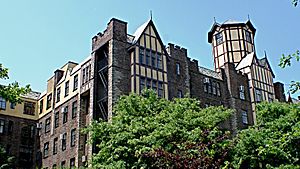
The name "Hudson Heights" started being used around 1993. A group of neighborhood activists formed the Hudson Heights Owners' Coalition. They chose this name carefully to promote the area. Real estate brokers began using the name after the group was formed.
The new name replaced the old reference to German heritage. Today, the German-speaking population is very small. While many Russian speakers still live there, Spanish speakers are much more common. English remains the main language.
The name "Hudson Heights" has been adopted by local arts groups and businesses. Newspapers like The Wall Street Journal and The New York Times now use the name. In 2007, Money magazine even called Hudson Heights the best neighborhood in New York City to retire to.
People and Homes
In 2010, the population of the neighborhood (using the larger definition of its borders) was about 29,000 people. About 44% were non-Hispanic white, and 43% were Hispanic.
Most buildings in Hudson Heights were built before World War II. Many of them are in the Art Deco style. You can also see Tudor and other styles. Many of these apartment buildings are now co-ops or condos.
The largest apartment complexes were started by real estate developer Dr. Charles V. Paterno. Hudson View Gardens opened in 1924 as a co-op. This Tudor-style complex was designed by George F. Pelham. Pelham's son, George F. Pelham Jr., designed Castle Village, which was finished in 1939. It became a co-op in 1985.
In 2005, a large retaining wall at Castle Village collapsed onto the Henry Hudson Parkway. This wall was nearly 100 years old. The road was closed for over two and a half years and reopened in 2008.
Since the 1980s, many rental buildings in the area have become co-ops or condos. Hudson Heights has become a popular place for people who want to live in Manhattan but find downtown prices too high. They also like the larger homes available here.
Things to Do and Places to Eat
A well-known museum in the area is The Cloisters in Fort Tryon Park. It's where the Metropolitan Museum of Art displays its collection of Medieval art. Every September, the park hosts the Medieval Festival, a free event with people in costumes, food, and music.
Hudson Heights is one of the neighborhoods that takes part in The Art Stroll. This is an annual festival that shows off local artists. Public places in Washington Heights, Inwood, and Marble Hill become temporary galleries. They host readings, performances, and markets each summer.
Bennett Park is the highest natural point in Manhattan. It also has a marker on the ground showing where the walls of Fort Washington once stood during the Revolutionary War. The park was named after James Gordon Bennett Sr., who published the New York Herald. Bennett Park hosts the annual Harvest Festival in September and a children's Halloween Parade.

You can find many small shops on West 181st Street at the southern end of the neighborhood. There are also shops along Broadway. In the middle of Hudson Heights, there's a small shopping area on West 187th Street between Cabrini Boulevard and Fort Washington Avenue.
News about Upper Manhattan is published weekly in The Manhattan Times, a newspaper in both English and Spanish. It has a guide to the area's growing restaurant scene. Events are also listed online.
Nearby is the United Palace, a church, music venue, and cultural center. It was built in 1930 as Loew's 175th Street Theatre, a grand movie palace. It showed films and live vaudeville acts until 1969. That year, Reverend Ike bought it and turned it into his church. The building was named a New York City landmark in 2016.
Public Services
Fire Safety
Hudson Heights is protected by the New York City Fire Department (FDNY)'s Engine Company 93/Ladder Company 45/Battalion 13. Their station is at 515 West 181st Street.
Post Office and Zip Codes
Hudson Heights uses two ZIP Codes. The area south of 187th Street is 10033, and the area north of 187th Street is 10040. The United States Postal Service has two post offices nearby: the Washington Bridge Station and the Ft George Station.
Religion
The Hebrew Tabernacle of Washington Heights is a Reform synagogue located at 551 Fort Washington Avenue. It's across from Bennett Park. The building has an Art Deco style. The Hebrew Tabernacle Congregation bought the building in 1973. Many of its members came to New York in the 1930s as Jewish refugees from central Europe.
The Roman Catholic patron saint of immigrants, Mother Francesca Saverio Cabrini, is buried at her shrine near the northern end of Fort Washington Avenue. Cabrini was America's first saint. The street on the west side of the shrine was renamed Cabrini Boulevard in 1938.
Washington Heights is also home to Khal Adath Jeshurun (KAJ), a German-Jewish congregation. It keeps the traditional German-Jewish way of worship.
Other churches and synagogues in the area include Our Saviour's Atonement Lutheran Church, Uptown Community Church, and Fort Washington Collegiate Church.
Education
Schools
For students in kindergarten through 8th grade, Hudson Heights is zoned for P.S./I.S. 187 Hudson Cliffs. In the 2016–2017 school year, 51% of its students met state standards in both English and Math. This is better than the citywide averages.
Another public school nearby is P.S. 173, for grades pre-K through 5.
The Roman Catholic Mother Cabrini High School used to be in the neighborhood. It closed in 2014, and the building is now a Success Academy Charter School.
Private schools in the wider area include the Osher Early Learning Center and the Medical Center Nursery School.
Library
The closest New York Public Library (NYPL) branch is the Fort Washington branch. It is located at 535 West 179th Street. This three-story Carnegie library opened in 1979.
Transportation

The subway entrances in Hudson Heights are quite special. The entrance at Fort Washington Avenue and West 193rd Street leads to the 190th Street station. This is the only New York City Subway entrance built in the Gothic style. It was listed on the National Register of Historic Places in 2005. This station is also one of the deepest in the entire subway system.
The 184th Street entrance of the 181st Street station also stands out. Both stations have elevators that connect Hudson Heights (on top of the ridge) to the Broadway valley below. These elevators are now free for everyone to use, making it easier to get around.
The George Washington Bridge Bus Terminal, at West 179th Street and Fort Washington Avenue, was designed by Italian architect Pier Luigi Nervi and built in 1963. The huge ventilation ducts look like concrete butterflies.
The George Washington Bridge itself is famous. The architect Le Corbusier called it "the most beautiful bridge in the world." Beneath the bridge is the Little Red Lighthouse. A festival is held there in late summer, and a long recreational swim finishes there in early autumn. It's also a popular spot to watch for peregrine falcons and the monarch butterfly migration.
Streets
The main north-south streets in Hudson Heights are:
- Fort Washington Avenue – named after Fort Washington, a key fort during the American Revolutionary War.
- Pinehurst Avenue – named after "Pinehurst," the estate of a sheepskin manufacturer.
- Cabrini Boulevard – formerly "Northern Avenue," renamed in 1938 for Mother Cabrini, who later became a saint.
- Overlook Terrace – named for the great view from the top of the street.
- Bennett Avenue – named after James Gordon Bennett, Sr., who founded the New York Herald newspaper. His name is also on Bennett Park.
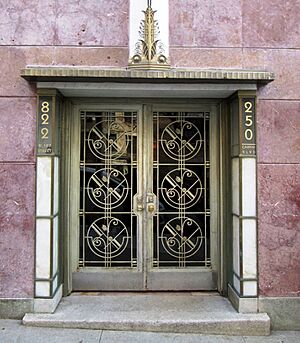
Other named streets in the neighborhood include:
- Alex Rose Place (West 186th Street) – named after Alex Rose, a labor leader and political figure who lived nearby.
- Chittenden Avenue – named in 1911 after Lucius Chittendon, an early landowner. This street offers wide views of the George Washington Bridge and the Palisades.
- Colonel Robert Magaw Place – named after Col. Robert Magaw, who commanded American forces at Fort Washington.
- Jacob Birnbaum Way (part of Cabrini Boulevard) – named after Jacob Birnbaum, a human rights activist who lived at Cabrini and West 187th Street.
- Margaret Corbin Circle and Margaret Corbin Drive – named after Margaret Corbin, a heroine of the American Revolution. She was the first female pensioner of the United States.
- Paterno Trivium (intersection of Cabrini Boulevard, Pinehurst Avenue, and West 187th Street) – named after Dr. Charles V. Paterno, the real estate developer who built Hudson View Gardens and Castle Village. This small garden with benches was dedicated in 2001.
- Plaza Lafayette (West 181st Street) – named after the Marquis de Lafayette, a French hero of the American Revolution. This plaza offers views of the Henry Hudson Parkway, the George Washington Bridge, the Hudson River, and the Palisades.
Parks
Parks in Hudson Heights include:
- Fort Tryon Park – a large, 67-acre (27 ha) park given to the city by John D. Rockefeller Jr. in 1931. It is home to The Cloisters, which holds Medieval art.
- Bennett Park – the site of Fort Washington during the Revolutionary War. It's named after James Gordon Bennett Sr. and is the highest natural point in Manhattan.
- J. Hood Wright Park – located between Fort Washington and Haven Avenues. It's named for James Hood Wright, a banker and philanthropist, and has a recreation center.
- Fort Washington Park – runs along the Hudson River. It includes the Little Red Lighthouse.
Famous People Who Lived Here
Some notable people who have lived in Hudson Heights include:
- C. K. G. Billings, an industrialist whose estate became Fort Tryon Park.
- Jacob Birnbaum, an activist for Soviet Jews.
- Rabbi Joseph Breuer, a religious leader.
- Mother Francesca Saverio Cabrini, a missionary and saint.
- Laurence Fishburne, an actor.
- Henry Kissinger, a famous diplomat.
- Daniel D. McCracken, an early computer pioneer.
- Lin-Manuel Miranda, the playwright, actor, and musician who created In The Heights and Hamilton. He owns homes in Castle Village.
- Charles V. Paterno, the real estate developer who built Hudson View Gardens and Castle Village.
- Alex Rose, a labor leader.
- Rabbi Shimon Schwab, a religious leader.
Hudson Heights in Pop Culture
The 1985 film We Were So Beloved tells the stories of Jewish residents in the neighborhood who escaped the Holocaust. The musical In The Heights, which started in 2007, takes place on 181st Street and Fort Washington Avenue. It was written by Lin-Manuel Miranda, who grew up in northern Manhattan. In 2007, the novel The Brief Wondrous Life of Oscar Wao by Junot Diaz mentioned Anglo women with yoga mats in the neighborhood as a sign of new changes. This book won the Pulitzer Prize in 2008.
Images for kids
-
The Fort Tryon Park Cottage is a remnant of one of the estates which abounded in the area
See also
 In Spanish: Hudson Heights (Manhattan) para niños
In Spanish: Hudson Heights (Manhattan) para niños


